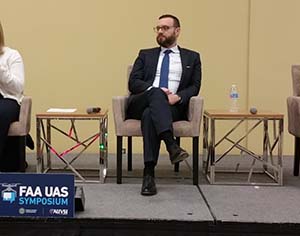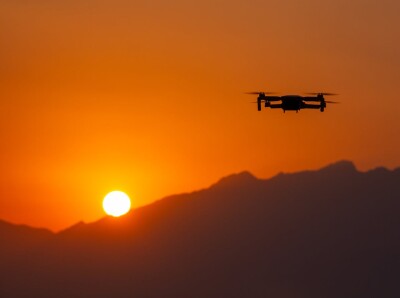Commercial drone regulation continues to be an issue that operators across the world talk about as their top concern. There are ongoing debates about whether restrictions that vary from region to region and country to country related to drone use are too strict or lax. It’s a situation that some have referred to as a “patchwork quilt” of drone regulations, and that’s created difficulties for operators and for stakeholders interested in the development of a centralized unmanned traffic management (UTM) system and U-Space that would enable drones to take to the sky in a safe and secure manner.

Lorenzo Murzilli speaking at the FAA UAS Symposium.
These issues are the exact ones that Lorenzo Murzilli is focused on resolving from a regulatory and technological standpoint. As Manager, Innovation and Advanced Technologies at Federal Office of Civil Aviation Switzerland, Murzilli is focused on making sure the risk management process and policy of drone operations in Switzerland makes sense for operators of all types. As a member of the
GUTMA (Global UTM Association) Board of Directors, he’s also part of an effort to see that sensible rules related to operating drones for a variety of purposes can be applied and enabled across Europe and even the entire world.
These efforts are just part of the reason he’s become a mainstay at
industry events, where he’s discussed what it means to enable global integration and risk mitigation in UAS operations. These are the places where conversations about the importance of allowing drones to be seamlessly integrated into the airspace take center stage, but they certainly aren’t the only things being talked about.
Creating a New FrameworkThe Innovation and Advanced Technologies office at the Federal Office of Civil Aviation Switzerland was established to deal with everything that didn't fit into their existing aviation framework in an agile way. It represents an especially sensible approach, especially because Switzerland does not make a distinction between commercial and non-commercial drone operations. Their efforts are all about ensuring that their levels of safety are not unnecessarily high, but at the same time, not so low that they cause accidents and stifle development.
“It's really about creating legal frameworks that support safe operations and safe integrations, but at the same time guarantees competitiveness at national levels while also enabling the drone service market,” Murzilli told Commercial UAV News. “It's about ensuring that everyone in the airspace can stay safe, but doing so without imposing requirements that won't allow the industry to develop. It’s really about finding the right balance between those two extremes.”
Striking that balance is easier said than done, and it’s an issue that industry leaders and regulators across the world are struggling with. Doing so is really about recognizing that innovative technology like drones means that assumptions and the old way of doing things just don't apply or work. This fact has driven a real need to create something new from a legal point of view. Government can be an enabler in these circumstances, but doing so with drone technology means understanding where and how commercial operations can scale, and that really can’t happen without a UTM system.
Thankfully, the development of this exact type of system is also something Murzilli is especially focused on doing.
What Will It Take to Create a UTM System?We’ve discussed the ongoing efforts that are taking place in the United States to
define and enable a UTM system for drones, and those efforts have a great deal of crossover around
drone regulation and U-space integration across Europe. Conversations about how all of this can and should be working are ongoing, and these are discussions that GUTMA is working to enable across a variety of industries, countries, technologies and stakeholders.
“GUTMA is a place where people that don't traditionally share the same environments can come together and have a discussion,” Murzilli continued. “We have communication people, aviation people, IT people, and plenty more. They're all groups that have a very strong culture and are very different. GUTMA is a place to get all these people to share and communicate. We want to be part of this conversation and educate ourselves on the culture and point of view of people that we've never interfaced with. That's the real good GUTMA is doing.”
It sounds like such a simple concept, but this kind of communication doesn’t always happen within an organization, much less across such great physical and cultural divides. The technology to deploy certain U-Space and UTM services is ready right now, but what’s missing is the regulatory framework that will allow those services to exist. The need for communication protocols is among the key elements of
full integration of pan-European regulations.
This kind of communication and collaboration is what GUTMA and other
industry events have enabled, and they’re critical because they’re discussions around what it means to create regulatory frameworks as soon as possible and truly open up the skies.
A Single Set of Rules for Europe and the WorldMurzilli often talks about global integration, harmonization and risk assessment when he’s involved in a panel discussion, and those topics all came up in different ways
at the FAA UAS Symposium. His perspective on these issues stems from a look at drone technology that doesn’t break things down into “commercial” and “non-commercial” operations, which in some ways simplifies the issue. If you’re trying to create a risk-based approach to drone operations, these kinds of distinctions don’t matter, and regulation that comes from this risk-based perspective is something more and more people are talking about and embracing.
“The key challenge with global integration and harmonization is about striking the right balance between something that is conducive to scalability but also respects the differences that exist between different nations or even localities,” Murzilli said. “It’s become clear that the best way to achieve this is to create performance and risk-based regulation. If you have a vision that can define harmonized objectives and high-level methodologies, you’ll have a consistent way to analyze this risk, and that will give you something that can be exported worldwide that everyone can use in the same way.”
This kind of vision around a risk-based approach to drone operations is not a new concept, but getting different stakeholders across the world to understand how it can work is a new development. It's complex technology, and stakeholders that are not as familiar with aviation principles are still trying to determine the right level of safety that needs to be established. Creating connections between technology and a sensible legal framework level is crucial, and it’s something that industry stakeholders and regulators need to be working through on a variety of levels.
Thankfully, it’s clear that these ongoing efforts will help ensure these discussions are taken to the next level. They’re what will ultimately drive the creation of a system that sees drones seamlessly integrated into the airspace across the world.
















Comments